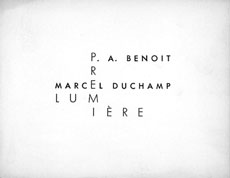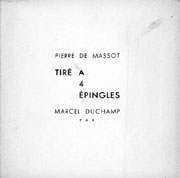By no means complete and, on more than one occasion, eminently perfectible, this bibliography aspires nevertheless to offer the first gathering of the names of writers and the titles of literary works that are related, either directly or indirectly, to Marcel Duchamp or to the work of Marcel Duchamp.
For matters of clarification, entries have been arranged chronologically in each of the four sections. If a book is reprinted or initially published in a paperback edition, this is indicated. If a book is translated, in full or in part, in English or in French, this is also indicated.
The four sections are the following:
I. Those who have published
a. at least one book, chapter, or article on the work of Marcel Duchamp, or an interview with him, as well as
b. a literary work (novel, collection of short stories, poetry, play).
II. Those who have published a literary work (novel, short story, play, etc.) which was “inspired” or “partially inspired” by the work of Marcel Duchamp or Duchamp himself.
III. Those who have published a literary work (novel, short story, poem, etc.) “in honor of” or “in partial honor of” Marcel Duchamp or his work.
IV. Literary works “illustrated” by Marcel Duchamp (alone or in collaboration) or by Marcel Duchamp and another artist.
Recognition of the first important work by Duchamp, of several works by Duchamp, and of what we’ve agreed to collectively call “the art of Marcel Duchamp” truly began in 1913 – with public recognition from the Americans (at the Armory Show, 1913) and critical recognition from the French (Apollinaire, 1913). Although more developed on the English-speaking side, the connections between art and literature, if one were to consider them, seem clearly more constant, even more consistent, on the French-speaking side. No relation of cause and effect here, but a simple observation: quite a lot of those who have written or will write about Marcel Duchamp have written or will also write (most often in French) literary texts.
André Gervais Janvier 2000
*******************
Those who have published a. at least one book, chapter, or article on the work of Marcel Duchamp, or an interview with him, as well as b. a literary work (novel, collection of short stories, poetry, play).
Note : In each case, the publication date of (a) is provided first, in brackets, before the author’s name. Following the author’s name is a list of his/her literary texts. Where an author has published a number of literary texts, the choice has been limited to four.
[1913, Chapter] Guillaume Apollinaire, pseud. de Wilhem Apollinaire de Kostrowitzky (1880-1918)
- L’enchanteur pourrissant With a portrait by Pablo Picasso. Paris : Mercure de France, 1913; Paris: Gallimard, coll. “Poésie/Gallimard”; Alcools. Translated by Anne Hyde Greet, with a foreword by Warren Ramsey. Berkeley: University of California Press, 1965; Alcools. Translated by Donald Revell. Hanover: University Press of New England for Wesleyan University Press, 1995.
- Le poète assassiné, With a portrait by André Rouveyre. Paris: Bibliothèque des curieux, 1916; Paris: Gallimard, coll. “Poésie / Gallimard”; The Poet Assassinated. Translated with a bibliographical notice and notes by Matthew Josephson. New York: The Broom Pub. Co., 1923; The Poet Assassinated. Translated by Ron Padgett, illustrated by Jim Dine. New York: Holt, Rinehart and Winston, 1968.
- Calligrammes, [Poems of peace and war 1913-1916]. With a portrait by Pablo Picasso. Paris : Mercure de France, 1918; Paris: Gallimard, coll. “Poésie / Gallimard “; Calligrammes. Translated by Anne Hyde Greet, with an introduction by S. I. Lockerbie and commentary by Anne Hyde Greet and S. I. Lockerbie. Berkeley: University of California Press, 1980.
[1917, Article-entrevue] Mina Loy, pseud. de Mina Lowy (1882-1966)
- Lunar Baedecker [sic], Paris: Contact Publishing Company, 1923; Lunar Baedeker & Time-tables. Highlands, NC: Jonathan Williams, 1958; The Last Lunar Baedeker. Edited and introduced by Roger L. Conover. Highlands, NC: The Jargon Society, 1982; The Lost Lunar Baedeker. Definitive edition, edited and introduced by Roger L. Conover. New York: Farrar, Straus & Giroux, 1996
[1917, Article]Louise Varèse, née Louise McCutcheon (1890-1988)
- St.-John Perse. Éloges, and other poems, French text with English translation by Louise Varèse and introduction by Archibald MacLeish, New York, W.W. Norton & Co, 1944.
- Charles Baudelaire. Paris Spleen, translated by Louise Varèse, New York, New Directions, 1947.
- Marcel Proust. Pleasures and Regrets, translated by Louise Varèse, with a preface by Anatole France, New York, Crown Publishers, 1948.
- Varèse: A Looking-Glass Diary, Volume 1, 1883-1928; New York, W.W. Norton & Co, 1972.
[1922, Article] André Breton (1896-1966)
- Nadja [1928], [story] Completely revised edition, by the author. Paris: Gallimard, 1963; coll. “Folio”; Nadja. Translated by Richard Howard. New York: Grove Press, 1960 and London: Evergreen Books, Ltd., 1960.
- Arcane 17 [1944, with four colored tarot strips by Matta] enté d’Ajours. With three etchings by Baskine. Paris: Éd. du Sagittaire, 1947; coll. “10 / 18 “; Arcanum 17 : With Apertures : Grafted to the End. Translated by Zack Rogow, with an introduction by Anna Balakian. Toronto: Coach House Press, 1994.
- Clair de terre(1) , [poems]. Preface by Alain Jouffroy. Paris: Gallimard, coll. “Poésie / Gallimard,” 1966.
- Signe ascendant(2) , Paris: Gallimard, coll. “Poésie / Gallimard,” 1966
[1924, Preface] Gertrude Stein (1874-1946)
- Geography and Plays, Boston, The Four Seas Company, 1922.
- The Making of Americans, Being a History of a Family’s Progress , novel, Paris, Contact Editions, 1925; Américains d’Amérique, histoire d’une famille américaine, traduction de la baronne J. Seillère et de Bernard Faÿ, Paris, Stock, Delamain et Boutelleau, 1933.
- The Autobiography of Alice B. Toklas, London, John Lane, The Bodley Head, 1933;Autobiographie d’Alice Toklas, traduction de Bernard Faÿ, Paris, Gallimard, 1934.
- Everybody’s Autobiography, New York, Random House, 1937; Autobiographies, traduction de la baronne d’Aiguy [May Tagnard], Paris, Éd. Confluences, 1945.
[1924, Book]
- Pierre de Massot (1900-1969)
- Prolégomènes à une éthique sans métaphysique ou Billy, bull-dog et philosophe [essay]. Paris: Éditions de la Montagne, 1930.
- Mon corps, ce doux démon [written 1932] [autobiography]. Letter-preface by André Gide, with an engraved portrait by Jacques Villon, s.l.n.d. [Alès: PAB, 1959].
- Le mystère des maux [poems]. With a drawing by Francis Picabia. Paris: hors commerce [Imprimerie René Martinet et Cie], 1961.(3)
- Le déserteur. Oeuvre poétique 1923-1969, texts collected and presented by Gérard Pfister, Paris, Arfuyen, 1992.(4)
[1936, article] Michel Leiris
- L’âge d’homme published 1939]. Preceded by: De la littérature considérée comme une tauromachie [1946] [first autobiography]. Paris: Gallimard, 1946; Paris: Gallimard, coll. “Folio”; Manhood : A Journey from Childhood into the Fierce Order of Virility. Preceded by: The Autobiographer as Torero. Translated by Richard Howard. New York: Grossman Publishers, 1963.
- La règle du jeu. Tome I: Biffures,Tome II: Fourbis, Tome III: Fibrilles [and] Tome IV: Frêle bruit [second autobiography]. Paris: Gallimard, respectively 1948, 1955, 1966 and 1976: the four volumes, coll. “L’imaginaire”; Rules of the Game: Scratches [Biffures]. Translated by Lydia Davis. New York: Paragon House, 1991 [Baltimore, MD: Johns Hopkins University, 1997]; Scraps [Fourbis]. Translated by Lydia Davis. Baltimore, MD: Johns Hopkins University, 1997.
- Mots sans mémoire (5), Paris, Gallimard, 1969.
- Journal 1922-1989,Critical edition presented and annotated by Jean Jamin. Paris: Gallimard, 1992.
[1937, article] Roger Caillois (1913-1978)
- Art poétique, Paris, Gallimard, 1958.
- Esthétique généralisée, Paris, Gallimard, 1962.
- Pierres, Paris, Gallimard, 1966.
- Obliques [1967] précédé de Images, images… [1966], Paris, Gallimard, coll. ” Le monde ouvert “, 1974.
[1938, article-entrevue; 1959, livre] Robert Lebel (1901-1986)
- Masque à lame, Illustrated by Isabelle Waldberg. New York: Éd. Hémisphères, 1943.
- L’oiseau caramel,, Illustrated by Max Ernst. Paris: le Soleil noir, 1969.
- La Saint-Charlemagne, illustré par Max Ernst, Paris, le Soleil noir, 1976.
[1945, article] Man Ray, pseud. d’Emmanuel Radnitsky (1890-1976)
- Self portrait [begun 1951, published 1963] [autobiography]. Foreword by Merry A. Foresta. Afterword by Juliet Man Ray. Boston: Little, Brown & Co., and the New York Graphic Society, 1988; Autoportrait. Translated into French by Anne Guérin. Paris: Laffont, 1964; Arles: Actes Sud, coll. “Babel.”
- Ce que je suis et autres textes, Presented by Vincent Lavoie. Paris: Hoëbeke, coll. “Arts & esthétique,” 1998.
[1945, article] Nicolas Calas [pseud.], [also known as Nikolas Kalas], Nikos Kalamares (1907- )
- Odos Niketa Randou [Rue Nikita Randou], poèmes, Athènes, Ikaros, 1977.
[1949, article] Gaston Puel (1924-)
- Paysage nuptial, frontispice de Hans Bellmer, Paris, GLM, 1947.
- La jamais rencontrée, frontispice de Max Ernst, Paris, Seghers, 1950.
- Ce chant entre deux astres, collage de Jean Arp en double frontispice, Lyon, Henneuse éd., 1956.
- Le cinquième château, avec deux bois originaux de Raoul Ubac, Veilhes, la Fenêtre ardente, 1965.
[1950, article; 1974, livre] Jean Suquet (1928-)
- Jamais rien ni personne, Enhanced with an engraving faded by time. Paris: le Parler de la lune aphasique, 1958.
- Une chimie greffée de chimères,Paris: le Parler de la lune aphasique, 1972.
- Oubli sablier intarissable(6), n° spécial de la revue Liard, Bordeaux, 1996.
[1952, article; 1954, chapitre] Michel Carrouges, pseud. de Louis Couturier (1910-1988)
- Les portes dauphines, roman, Paris, Gallimard, 1954.
- Les grands-pères prodiges, roman, Paris, Plon, 1957.
[1953, article] Henri Pierre Roché (1879-1959)
- Jean Roc [pseud.]. Don Juan et… [story]. Paris: Éd. de la Sirène, 1921; Marseille: André Dimanche Éditeur, 1993.
- Jules et Jim [novel]. Paris: Gallimard, 1953; coll. “Folio”; Jules and Jim, translated by Patrick Evans. London and Boston: M. Boyars, 1963.
- Deux Anglaises et le continent, roman, Paris, Gallimard, 1956.
- Carnets. Les années Jules et Jim. Part one, 1920-1921. Foreword by François Truffaut. Marseille: André Dimanche Éditeur, 1990.
[1954, article-entrevue] Alain Jouffroy (1928-)
- Un rêve plus long que la nuit, roman, Paris, Gallimard, 1964; coll. ” Folio “.
- Trajectoire, récit-récitatif, Paris: Gallimard, 1968.
- Liberté des libertés, Illustrated by Joan Miró and Valerio Adami. Paris: le Soleil noir, 1971.
- L’ouverture de l’être 1947-1962, poèmes,Preface by Sarane Alexandrian. Paris: Éd. de la Différence, coll. “Littérature,” 1983.
[1957, article-entrevue] Jean Schuster (1929-1995)
- Les moutons, Paris, Éd. le Récipiendaire, 1978.
- Introduction and notes by Michel Déon. Paris: Éd. de la Table ronde, 1964; Paris: Gallimard, coll. “Idées”; Diary of a Genius. Foreword and notes by Michel Déon. Translated by Richard Howard. New York: Doubleday, 1965.
[1959, article] Salvador Dali (1904-1989)
- La vie secrète de Salvador Dali, Translated by Haakon M. Chevalier. New York: Dial Press, 1942; La vie secrète de Salvador Dali. Adapted by Michel Déon. Paris: Éd. de la Table ronde, coll. “Les vies perpendiculaires,” 1952; Paris: Gallimard, coll. “Idées.”.
[1963, article] John Cage (1912-1992)
- Silence, lectures and writings; A Year from Monday [new lectures and writings]; M [writings, ’67-’72]; Empty Words [writings, ’73-’78]; X [writings, ’79-’82]; Middletown (CT): Wesleyan University Press, respectively 1961, 1967, 1973, 1979 and 1983; Silence. Translated into the French by Monique Fong. Paris: Denoël, 1970.
- Pour les oiseaux, Dialogues with Daniel Charles. Paris: Belfond, 1976; For the Birds, Boston: M. Boyards, 1981.
[1964, chapitre; 1967, livre] Arturo Schwarz (1924-)
- Choix de poèmes [en français], Paris, Seghers, 1956.
- Il Reale Assoluto, With eleven lithographs by Marcel Duchamp and Man Ray. Milan: Galleria Schwarz, 1964..
- Per Vera, poems In Italian. With a portrait of Vera by Franco Francese. Milan: Penna di Pollo Editore, 1984.
- A coat made of wind, n English. With an engraving by Ofer Lellouche. Tel-Aviv: The Genia Shreiber University Art Gallery, Tel Aviv University, 1994.
[1968, article] Denis de Rougemont (1906-1985)
- L’amour et l’occident, essay [1939], Revised edition. Paris: Plon, 1956; Paris: UGÉ, coll. “10 / 18”; Love in the Western World. Revised and augmented edition. Translated by Montgomery Belgion. New York: Pantheon, 1956. [The other title of this translation is Passion and Society, London: Faber and Faber, 1956].
- La part du diable [fin 1942],New version. Neuchâtel: la Baconnière, 1945; The Devil’s Share [essay]. On the diabolic in modern society. Translated by Haakon M. Chevalier. New York: Meridian Books, 1956.
- Lettres sur la bombe atomique, Paris, Gallimard, 1946.
- Journal d’une époque 1926-1946, Paris: Gallimard, 1968. [Revised edition of Journal des deux mondes, 1947.].
[1968, livre] Octavio Paz (1914-1998)
- Liberté sur parole [translated into French, 1966], followed by: Condition de nuage, Aigle ou soleil [1951], À la limite du monde [1942], and Pierre de soleil [1957, translated into French, 1962] [poems]; Translated from the Spanish by Jean-Clarence Lambert (reviewd by the author) and Benjamin Péret. Paris: Gallimard, coll. “Poésie / Gallimard,” 1971.
- Versant Est [Ladera Este (1962-1968), Translated from the Spanish into French by Yesé Amory et al. Paris: Gallimard, 1970; coll. “Poésie / Gallimard.”
- The collected poems of Octavio Paz, 1957-1987, Edited and translated into English by Eliot Weinberger, with additional translations by Elizabeth Bishop et al. New York: New Directions, 1987.
- Le singe grammairien, Translated into the French by Claude Esteban. Geneva: Skira, coll. “Les sentiers de la création,” 1972; The Monkey Grammarian. Translated into the English by Helen R. Lane. New York: Seaver Books, 1981.
[1969, article] Bernard Teyssèdre (1930-)
- Romans-éclairs, Paris, Grasset, 1961.
- Foi de fol, [comical story entangled with plagiarism and examples]. Paris: Gallimard, coll. “Le chemin,”1968.
- Le roman de l’Origine, Paris: Gallimard, coll. “L’Infini,” 1996.
[1971, article] José Pierre (1927-1998 ?)
- Qu’est-ce que Thérèse? C’est les marronniers en fleurs, roman, Paris, le Soleil noir, 1974; coll. ” J’ai lu. Pour lecteurs avertis “.
- La charité commence par un baiser, Paris: Galilée, coll. “Ligne fictive,” 1980.
- Les barreaux du coeur, roman, Paris, Mercure de France, coll. ” Le Mercure galant “, 1986.
- La fontaine close. Mercure de France, coll. “Le Mercure galant,” 1986.
La fontaine close. Les livres secrets d’une secte gnostique inconnue. Paris: l’Instant, coll. “Griffures,” 1988.
[1972, article] Marcelin Pleynet (1933-)
- Stanze. Incantation dite au bandeau d’or, Paris, Seuil, coll. ” Tel quel “, 1973.
- Rime, Paris, Seuil, coll. ” Tel quel “, 1981.
- Le jour et l’heure, journal, Paris, Plon, coll. ” Carnets “, 1988.
- La vie à deux ou trois, roman, Paris, Gallimard, 1992.
[1973, article] David Antin (1932-)
- Selected Poems 1963-1973, Los Angeles: Sun & Moon Press, coll. “Sun & Moon classics,” 1991; Poèmes parlés. Translated into the French by Jacques Darras et al., preface by Jacques Darras. Saint-Pierre-du-Mont: les Cahiers des brisants, coll. “les Cahiers de Royaumont,” 1984.
- La voix de son maître, Paris, Gallimard, 1973.
- La scène primitive, Paris, Gallimard, 1984; coll. ” L’imaginaire “.
- Adieu Kafka, roman, Paris, Gallimard, 1989.
- Bartoldi le comédien, roman, Paris, Seuil, 1996.
- Les armes parlantes. Pratique de la poésie, Paris, Belfond, 1976.
- Idylles précédé de Féminaire, dessins de Corneille, Paris, Galilée, coll. ” Écritures, figures “, 1985.
- Poésie en jeu 1953-1973, Paris, Galilée, coll. ” Écritures, figures “, 1986.
- Le jardin le labyrinthe 1953-1989, poèmes, prologue d’Octavio Paz, Paris, Éd. de la Différence, coll. ” Littérature “, 1991.[1974, article] Gilbert Lascault (1934-)
- Enfances choisies, Paris, Bourgois, 1976.
- Encyclopédie abrégée de l’Empire vert, Paris, Maurice Nadeau: Papyrus, coll. ” Lettres nouvelles “, 1983.
- Éloges à Geneviève, Paris, Balland, 1985.
- Les amours d’Arthur-Toujours-Là et de Monika-Belle-de-Givre, mies de pain de Pétra Werlé, Strasbourg, Baby Lone, coll. ” L’île sonnante “, 1986.
- La modification, roman, Paris, Minuit, 1957; coll. ” 10 / 18 “.
- Mobile, étude pour une représentation des États-Unis, Paris, Gallimard, 1962; Mobile, study for a representation of the United States, translated by Richard Howard, New York, Simon and Schuster, 1963.
- Matière de rêves, Matière de rêves II. Second sous-sol, Matière de rêves III. Troisième dessous et Matière de rêves IV. Quadruple fond, Paris, Gallimard, coll. ” Le chemin “, respectivement 1975, 1976, 1977, 1981.
- Envois et Exprès. (Envois 2), poèmes, Paris, Gallimard, coll. ” Le chemin “, 1980 et 1983.
- Gérard Régnier, Les chemins détournés, roman, Paris, Gallimard, 1962.
- Le voyageur égoïste, carnets de voyage 1978-1988, Paris, Plon, coll. ” Carnets “, 1989.
- Onze chansons puériles, numérotées par Pierre Alechinsky (1927-), Caen, l’Échoppe, 1990.
- Le déconcerto, contes, Paris, Galilée, coll. ” Ligne fictive “, 1980.
- L’aventure en soi, autobiographie, Paris, Mercure de France, 1990.
- Le grand astrosophe, roman, Paris, Losfeld, 1994.
- Récits tremblants, avec Jacques Monory (1934-), Paris, Galilée, 1977.
- Le mur du Pacifique, récit, Paris, Galilée, coll. ” Ligne fictive “, 1979.
- L’histoire de Ruth, avec Ruth Francken (1924-), Talence, le Castor astral, coll. ” Le mot et la forme “, 1983.
- Trop plein pollen, poèmes, revue Les Herbes rouges, Montréal, n° 23, 1974.
- Hom storm grom suivi de Pré prisme aire urgence, poèmes, Montréal, Éd. de l’Aurore, coll. ” Lecture en vélocipède “, 1975.
- Du muscle astérisque, proses, revue La Nouvelle Barre du jour, Montréal, série ” Auteur / e “, n° 180, 1986.
- La nuit se lève, poèmes et proses, avec un tableau de Bruno Santerre. Saint-Lambert, Éd. du Noroît, 1990.
- Rrose Sélavy, [written October 1922-1923] [aphorisms]. Published in part in Littérature, new series: no. 7 (Paris, December 1, 1922); published in part (but with variation) in Corps et biens. Paris: Gallimard, 1930; coll. “Poésie / Gallimard.”
- [La double vue [written from November 1922 to December 1923]. In Corps et biens. Paris: Gallimard, 1930; coll. “Poésie / Gallimard.”
- Passage de Milan (7), [written 1950-1951] [novel]. Paris: Minuit, 1954; coll. “10 / 18.”
- Victor, [written 1957] [novel, left unfinished]. Critical edition by Danielle Régnier-Bohler, preface and notes by Jean Clair. Paris: Centre Georges Pompidou, 1977.
- ” Le scorpion et la rose. Paris: Bourgois, 1970.
- Artist Descending A Staircase [play]. Performed for the first time on the airwaves of the BBC, November 14, 1972; in Artist Descending A Staircase and Where Are They Now?, two plays for radio. London: Faber and Faber, 1973; Artiste descendant un escalier, adaptation in French by Élisabeth Janvier. Martel: Éd. du Laquet, coll. “Théâtre en poche,” 1998.
- Triptyque, Paris: Minuit, 1973; Triptych. Translated by Helen R. Lane. New York: Viking Press, 1976.
- Topologie d’une cité fantôme (8), [novel]. Paris: Minuit, 1976; Topology of a Phantom City. Translated by J. A. Underwood. New York: Grove Press, 1977.
- Le miroir qui revient (9), Paris: Minuit, 1984; Ghosts in the Mirror. Translated by Jo Levy. London: J. Calder, 1988.
- Rrose Melody, Liège: Association Art Promotion, 1977..
- The Bride Stripped Bare, [record]. EMI, 1978; [compact disc]. Virgin 47606-2 (distributed by EMI).
- Le ruban au cou d’Olympia, Paris: Gallimard, 1981.
- Le ruban au cou d’Olympia, Paris: Fayard, 1982; Paris: Éd. J’ai lu, coll. “Policier.”
- Rrose, sa vie sans cachotteries dépeinte […], [epic poem]. 1150 verses. Hautot-le-Vatois (Normandy, France): Académie de Muséologie Évocatoire, 1985.
- La boîte verte, Éd. de la Différence, 1995.
- Chu dans mer sale ou La rumination polymorphe. Paris: la Bibliothèque oulipienne, no. 86, 1997.
- ” Love – chemical relationship” [poem]. Dedicated to Marcel Duchamp. In The Little Review, vol. 5, no. 2 (New York, June 1918).
- ” Mefk Maru Mustir Daas ” [poem]. Dedicated to Marcel Duchamp. In The Little Review, vol. 5, no. 8 (New York, December 1918).
- Pensées sans langage, [written from October (?) 1918 to March 1919] [poem in book form]. Dedicated thus: “Chers amis Gabrielle Buffet, Ribemont-Dessaignes, Marcel Duchamp, Tristan Tzara, je vous dédie ce poème en raison de notre sympathie élective.” (“My dear friends Gabrielle Buffet, Ribemont-Dessaignes, Marcel Duchamp, Tristan Tzara, I dedicate this poem to you because of our elective sympathy.”). Paris: Eugène Figuière, 1919; Écrits, Volume I: 1913-1920. Paris: Belfond, coll. “Les bâtisseurs du XXe siècle,” 1975.
- ” À Rrose Sélavy “, [poem]. In Clair de terre. Paris: coll. “Littérature,” 1923; Earthlight, translated by Bill Zavatsky and Zack Rogow. Los Angeles: Sun & Moon Press, 1993.
- ” Mode d’emploi ” [written June 8, 1923] [poem]. Dedicated to Rrose Sélavy: “pour Rrose Sélavy”]. In Poésie 1, no. 23: Jacques Baron, Pierre de Massot, Philippe Soupault: trois poètes surréalistes (Paris, March 1972); Étant donné Marcel Duchamp, no. 2, (Baby [France], February 2000).”Jeu du ‘dans’ ” [written in early 1950’s (?)] [poem]. Dedicated to Marcel Duchamp: “pour Marcel Duchamp “. In Poésie 1, no. 23: Jacques Baron, Pierre de Massot, Philippe Soupault: trois poètes surréalistes, (Paris, March 1972); Étant donné Marcel Duchamp, no. 2, (Baby [France], February 2000).
- The Wonderful Book. Reflections on Rrose Sélavy, Paris: hors commerce [Imprimerie Ravilly], s.d. [1924]; Étant donné Marcel Duchamp, no. 2, (Baby [France], February 2000).
5 poëmes [written from 1931 to 1946] [poems]. Dedicated to Marcel Duchamp : “À Marcel Duchamp.” With a portrait of the author by Francis Picabia. Paris: hors commerce [Imprimerie Gaschet et Cie], 1946. - ” La force ” [poem]. Dedicated to Marcel Duchamp: “à Marcel Duchamp.” In Le mouvement perpétuel (poems 1921-1924). Paris: Gallimard, 1926.
- Marcel Duchamp [written November 8, 1939] [poem]. With a frontispiece by Marcel Duchamp. Paris: hors commerce, 1941.
- Avalanche, [novel]. Dedicated in English and in French: “To Monsieur and Madame Rrose Sélavy .” New York: Simon and Schuster, 1944.
- ” A complaint for Mary and Marcel.” In Collected poems. Port Townsend (Wa): Copper Canyon Press, 1970..
- Les pianos mécaniques, [written (in Cadaquès) from March 1961 to February 1962](10)[novel]. Paris: Laffont, 1962; coll. “Le livre de poche”; The Mechanical Pianos. Translated by Peter Wiles. New York: Farrar, Straus and Giroux, 1965.
- Agent provocateur, n[novel]. Dedicated in English: “For Marcel Duchamp.” Toronto: Coach House Press, 1976.
- Ubu roi [1896], Paris: Fasquelle, 1921; Reliure pour “Ubu roi” d’Alfred Jarry [1935]. Designed by Marcel Duchamp and created by Mary Reynolds. Ubu roi [drama in five acts]. Translated by Barbara Wright. London: Gaberbocchus P., 1966; Ubu Rex. Translated by David Copelin. Vancouver: Pulp Press, 1977; in Three Pre-Surrealist Plays. Translated with an introduction and notes by Maya Slater. Oxford and New York: Oxford University Press, 1997.
- Au lavoir noir, [poem]. With a window by Marcel Duchamp. Paris: GLM, coll. “Repères,” [January] 1936; Illustration pour “Au lavoir noir” d’André Breton (1935).
Young Cherry Trees Secured Against Hares / Jeunes cerisiers garantis contre les lièvres [selection of poems]. Translated by Édouard Roditi, with drawings by Arshile Gorky. New York: View Editions, [March or April] 1946; Couverture pour “Young Cherry Trees Secured Against Hares” d’André Breton (1945-1946). - La septième face du dé,[poems, paper cutouts]. Cover cigarettes by Marcel Duchamp. Paris: Éd. Jeanne Bucher, [May] 1936; Couverture pour “La septième face du dé” de Georges Hugnet (1936).
- Marcel Duchamp [written November 8, 1939] [poem]. With a frontispiece by Marcel Duchamp. Paris: hors commerce, 1941; Moustache et barbe de L.H.O.O.Q. (1941).
- Hebdomeros, Paris: Éd. du Carrefour, 1929; Reliure pour “Hebdomeros” de Giorgio de Chirico (1936-1939). Designed by Marcel Duchamp and created by Mary Reynolds.
- L’équilibre, [written in 1917] [poem]. With an engraving by Marcel Duchamp. Alès: PAB, [August] 1958.
- Première lumière, [poem]. With an engraving by Marcel Duchamp. Alès: PAB, [August] 1959.
- Tiré à quatre épingles, [poems]. With an engraving by Marcel Duchamp. Alès: PAB, [Summer] 1959.
- Marcel Duchamp. Propos et souvenirs, With a rectified readymade, in color, by Marcel Duchamp. Milan: chez Arturo Schwarz, 1965; L.H.O.O.Q. (replica, September 1964); Étant donné Marcel Duchamp, no. 2 (Baby [France] February 2000).
- Il Reale Assoluto, [poems]. In Italian. With eleven lithographies by Marcel Duchamp and Man Ray. Milan: Galleria Schwarz, 1964; Certificat de lecture (February-March 1964).
-
Pierre-André Benoit, Première
lumière, Alès: PAB, 1959 -
Pierre de Massot, Tiré
à quatre épingles, Alès: PAB, 1959 - La double vue suivi de L’inventeur du temps gratuit, With an etched diptych by Alberto Giacometti and a folding by Marcel Duchamp (in the first 111 exemplary copies), with an etching by Ferró (in the next 150 exemplary copies). Paris: le Soleil noir, 1964; La pendule de profil (1964).
*******************
2. Those who have published a literary work (novel, short story, play, etc.) which was “inspired” or “partially inspired” by the work of Marcel Duchamp or Duchamp himself;
Note: Names preceded by an asterisk have already been listed in Section I.
Elmer Ernest Southard (1876-1920)
” Mlle de l’escalier ” [novella, dictated into English, November 17, 1916]. In The Open Mind. Elmer Ernest Southard 1876-1920 by Frederick P. Gay. Chicago: Normandie House, 1938.
Elsa von Freytag-Loringhoven, (“The Baroness”), born Elsa Hildegard Ploetz (1874-1927)
“Portrait de Marcel Duchamp” [poem]. In English. The Little Review, vol. 9, no. 2 (New York, Winter 1922).
Henrie Waste, Henrietta (“Ettie”) Stettheimer (1874-1955)
Love Days [Susanna Moore’s], [written from 1919 (?) to 1922] [novel]. New York: Alfred A. Knopf, [August] 1923.
” Pensée-Cadeau: vers à un ami ” [Summer 1922] [poem]. In French. View, series 5, no. 1 (New York, March 1945)
Robert Desnos (1900-1945)
Rrose Sélavy [written October 1922-1923] [aphorisms]. Published in part in Littérature, new series: no. 7 (Paris, December 1, 1922); published in part (but with variation) in Corps et biens. Paris: Gallimard, 1930; coll. “Poésie / Gallimard.”
L’aumonyme [written from November 1922 to December 1923]. In Corps et biens. Paris: Gallimard, 1930; coll. “Poésie / Gallimard.”
Francis Picabia (1879-1953)
Caravansérail [written from June 1923 to January 1924] [novel]. Paris: Belfond, 1974.
[1974, article] Bernard Pingaud (1923-)
*******************
2. Ceux qui ont publié une oeuvre littéraire (roman, nouvelle, pièce, etc.) qui est ” inspirée ” ou partiellement ” inspirée ” par l’oeuvre ou la personne de Marcel Duchamp
N.B. Les noms précédés d’un astérisque sont déjà dans la section 1
Elmer Ernest Southard (1876-1920)
” Mlle de l’escalier ” [novelette, dictée le 17 novembre 1916], dans Frederick P. Gay, The Open Mind. Elmer Ernest Southard 1876-1920, Chicago, Normandie House, 1938.
Elsa von Freytag-Loringhoven, dite The Baroness, née Elsa Hildegard Ploetz (1874-1927)
” Portrait de Marcel Duchamp “, The Little Review, New York, vol. 9, n° 2, hiver 1922.
Henrie Waste, pseud. d’Henrietta, dite Ettie, Stettheimer (1874-1955)
Love Days [Susanna Moore’s], novel [écrit de 1919 (?) à 1922], New York, Alfred A. Knopf, [août] 1923.
” Pensée-Cadeau: vers à un ami ” [poème, été 1922], dans View, New York, série 5, n° 1, mars 1945.
[1974, article] Jean-Clarence Lambert (1930-)
*******************
2. Ceux qui ont publié une oeuvre littéraire (roman, nouvelle, pièce, etc.) qui est ” inspirée ” ou partiellement ” inspirée ” par l’oeuvre ou la personne de Marcel Duchamp
N.B. Les noms précédés d’un astérisque sont déjà dans la section 1
Elmer Ernest Southard (1876-1920)
” Mlle de l’escalier ” [novelette, dictée le 17 novembre 1916], dans Frederick P. Gay, The Open Mind. Elmer Ernest Southard 1876-1920, Chicago, Normandie House, 1938.
Elsa von Freytag-Loringhoven, dite The Baroness, née Elsa Hildegard Ploetz (1874-1927)
” Portrait de Marcel Duchamp “, The Little Review, New York, vol. 9, n° 2, hiver 1922.
Henrie Waste, pseud. d’Henrietta, dite Ettie, Stettheimer (1874-1955)
Love Days [Susanna Moore’s], novel [écrit de 1919 (?) à 1922], New York, Alfred A. Knopf, [août] 1923.
” Pensée-Cadeau: vers à un ami ” [poème, été 1922], dans View, New York, série 5, n° 1, mars 1945.
[1975, article] Michel Butor (1926-)
*******************
2. Ceux qui ont publié une oeuvre littéraire (roman, nouvelle, pièce, etc.) qui est ” inspirée ” ou partiellement ” inspirée ” par l’oeuvre ou la personne de Marcel Duchamp
N.B. Les noms précédés d’un astérisque sont déjà dans la section 1
Elmer Ernest Southard (1876-1920)
” Mlle de l’escalier ” [novelette, dictée le 17 novembre 1916], dans Frederick P. Gay, The Open Mind. Elmer Ernest Southard 1876-1920, Chicago, Normandie House, 1938.
Elsa von Freytag-Loringhoven, dite The Baroness, née Elsa Hildegard Ploetz (1874-1927)
” Portrait de Marcel Duchamp “, The Little Review, New York, vol. 9, n° 2, hiver 1922.
Henrie Waste, pseud. d’Henrietta, dite Ettie, Stettheimer (1874-1955)
Love Days [Susanna Moore’s], novel [écrit de 1919 (?) à 1922], New York, Alfred A. Knopf, [août] 1923.
” Pensée-Cadeau: vers à un ami ” [poème, été 1922], dans View, New York, série 5, n° 1, mars 1945.
[1975, livre] Jean Clair, pseud. de Gérard Régnier (1940-)
*******************
2. Ceux qui ont publié une oeuvre littéraire (roman, nouvelle, pièce, etc.) qui est ” inspirée ” ou partiellement ” inspirée ” par l’oeuvre ou la personne de Marcel Duchamp
N.B. Les noms précédés d’un astérisque sont déjà dans la section 1
Elmer Ernest Southard (1876-1920)
” Mlle de l’escalier ” [novelette, dictée le 17 novembre 1916], dans Frederick P. Gay, The Open Mind. Elmer Ernest Southard 1876-1920, Chicago, Normandie House, 1938.
Elsa von Freytag-Loringhoven, dite The Baroness, née Elsa Hildegard Ploetz (1874-1927)
” Portrait de Marcel Duchamp “, The Little Review, New York, vol. 9, n° 2, hiver 1922.
Henrie Waste, pseud. d’Henrietta, dite Ettie, Stettheimer (1874-1955)
Love Days [Susanna Moore’s], novel [écrit de 1919 (?) à 1922], New York, Alfred A. Knopf, [août] 1923.
” Pensée-Cadeau: vers à un ami ” [poème, été 1922], dans View, New York, série 5, n° 1, mars 1945.
[1976, livre] Sarane Alexandrian (1927-)
*******************
2. Ceux qui ont publié une oeuvre littéraire (roman, nouvelle, pièce, etc.) qui est ” inspirée ” ou partiellement ” inspirée ” par l’oeuvre ou la personne de Marcel Duchamp
N.B. Les noms précédés d’un astérisque sont déjà dans la section 1
Elmer Ernest Southard (1876-1920)
” Mlle de l’escalier ” [novelette, dictée le 17 novembre 1916], dans Frederick P. Gay, The Open Mind. Elmer Ernest Southard 1876-1920, Chicago, Normandie House, 1938.
Elsa von Freytag-Loringhoven, dite The Baroness, née Elsa Hildegard Ploetz (1874-1927)
” Portrait de Marcel Duchamp “, The Little Review, New York, vol. 9, n° 2, hiver 1922.
Henrie Waste, pseud. d’Henrietta, dite Ettie, Stettheimer (1874-1955)
Love Days [Susanna Moore’s], novel [écrit de 1919 (?) à 1922], New York, Alfred A. Knopf, [août] 1923.
” Pensée-Cadeau: vers à un ami ” [poème, été 1922], dans View, New York, série 5, n° 1, mars 1945.
[1977, livre] Jean-François Lyotard (1924-1998)
*******************
2. Ceux qui ont publié une oeuvre littéraire (roman, nouvelle, pièce, etc.) qui est ” inspirée ” ou partiellement ” inspirée ” par l’oeuvre ou la personne de Marcel Duchamp
N.B. Les noms précédés d’un astérisque sont déjà dans la section 1
Elmer Ernest Southard (1876-1920)
” Mlle de l’escalier ” [novelette, dictée le 17 novembre 1916], dans Frederick P. Gay, The Open Mind. Elmer Ernest Southard 1876-1920, Chicago, Normandie House, 1938.
Elsa von Freytag-Loringhoven, dite The Baroness, née Elsa Hildegard Ploetz (1874-1927)
” Portrait de Marcel Duchamp “, The Little Review, New York, vol. 9, n° 2, hiver 1922.
Henrie Waste, pseud. d’Henrietta, dite Ettie, Stettheimer (1874-1955)
Love Days [Susanna Moore’s], novel [écrit de 1919 (?) à 1922], New York, Alfred A. Knopf, [août] 1923.
” Pensée-Cadeau: vers à un ami ” [poème, été 1922], dans View, New York, série 5, n° 1, mars 1945.
[1977, article; 1984, livre] André Gervais (1947-)
*******************
2. Ceux qui ont publié une oeuvre littéraire (roman, nouvelle, pièce, etc.) qui est ” inspirée ” ou partiellement ” inspirée ” par l’oeuvre ou la personne de Marcel Duchamp
N.B. Les noms précédés d’un astérisque sont déjà dans la section 1
Elmer Ernest Southard (1876-1920)
” Mlle de l’escalier ” [novelette, dictée le 17 novembre 1916], dans Frederick P. Gay, The Open Mind. Elmer Ernest Southard 1876-1920, Chicago, Normandie House, 1938.
Elsa von Freytag-Loringhoven, dite The Baroness, née Elsa Hildegard Ploetz (1874-1927)
” Portrait de Marcel Duchamp “, The Little Review, New York, vol. 9, n° 2, hiver 1922.
Henrie Waste, pseud. d’Henrietta, dite Ettie, Stettheimer (1874-1955)
Love Days [Susanna Moore’s], novel [écrit de 1919 (?) à 1922], New York, Alfred A. Knopf, [août] 1923.
” Pensée-Cadeau: vers à un ami ” [poème, été 1922], dans View, New York, série 5, n° 1, mars 1945.
click to enlarge
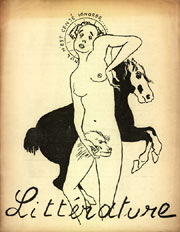
Cover of Littérature,
André Breton (ed.), N° 5, 1er October, 1922
Robert Desnos (1900-1945)
Robert Lebel
click to enlarge

Robert Lebel, La Double
Vue, Paris: Le Soleil noir, 1964
* Michel Butor
* Henri Pierre Roché
* Jean Suquet
Tom Stoppard, pseud. de Thomas Straussler (1937-)
click to enlarge

Henri Pierre Roché. Victor, vol. 4
of the four-volume publication
issued for the exhibition “L’Oeuvre de Marcel Duchamp,”
31 January – 2 May, 1977.
Paris: Centre Georges Pompidou
Claude Simon (1913-)
Alain Robbe-Grillet (1922-)
Jacques Charlier (…-)
Bryan Ferry (…-)
* Michel Leiris
Jean-François Vilar (1948-)
[1977, livre] Jennifer Gough-Cooper (…-) & Jacques Caumont (…-)
Michel Waldberg (1940-)
Walter Henry, pseud. de Paul Braffort (…-)
***********************
3.Those who have published a literary work (novel, short story, poem, etc.) “in honor of” or “in partial honor of” Marcel Duchamp or his work;
Note: Names preceded by an asterisk have already been listed in Section I.
Elsa von Freytag-Loringhoven
Francis Picabia
* André Breton
click to enlarge
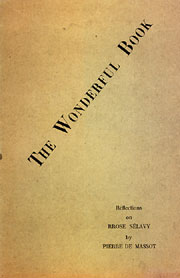
Pierre de Massot.
The Wonderful Book. Reflections on
Rrose Sélavy (1924), in Étant donné
Marcel Duchamp, n° 2, (Baby [France] February 2000),
pp. 97~120
* Pierre de Massot
Louis Aragon (1897-1985)
Georges Hugnet (1906-1974)
Kay Boyle (1902-1992)
Henri-François Rey (1919-1987)
David Young (1946-)
***********************
click to enlarge
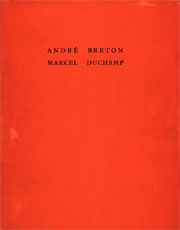
André Breton, Au Lavoir
noir, Paris: Éditions G.L.M, 1936
4. Literary works “illustrated” by Marcel Duchamp (alone or in collaboration) or by Marcel Duchamp and another artist.
Note: Names preceded by an asterisk have already been listed in Section I.
Alfred Jarry (1873-1907)
* André Breton
click to enlarge
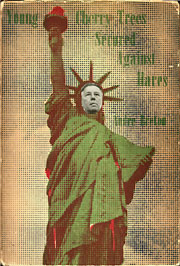
André Breton, Young Cherry
Trees Secured against Hares, Edward Roditi (trans.), New York:
View Editions, 1946
Georges Hugnet
Francis Picabia
Pierre-André Benoit (1921-1993)
click images to enlarge
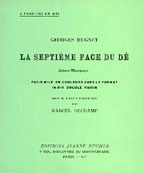
Georges Hugnet, La septiéme
face du dé, Paris: Éditions Jeanne Bucher, 1936

Georges Hugnet, Marcel Duchamp,
a poem and front piece with
Moustache et barbe de L.H.O.O.Q.
(1941) by Duchamp, Paris:
Hors Commerce, 1941
*Pierre de Massot
* Arturo Schwarz
click images to enlarge
* Robert Lebel
E-mail André Gervais with suggestions and comments: Andre_Gervais@uqar.uquebec.ca
Notes
 1. This retrospective contains Mont de piété [1919, with two drawings by André Derain], Clair de terre [1923, with a portrait by Pablo Picasso], L’union libre [1931], Le revolver à cheveux blancs [1932, with an etching by Salvador Dali], Violette Nozières [1933], L’air de l’eau [1934, with four engravings by Alberto Giacometti] and Au lavoir noir [1936, with a window by Marcel Duchamp].
1. This retrospective contains Mont de piété [1919, with two drawings by André Derain], Clair de terre [1923, with a portrait by Pablo Picasso], L’union libre [1931], Le revolver à cheveux blancs [1932, with an etching by Salvador Dali], Violette Nozières [1933], L’air de l’eau [1934, with four engravings by Alberto Giacometti] and Au lavoir noir [1936, with a window by Marcel Duchamp].
 2. This retrospective contains [Poèmes 1935-1940], Pleine marge [1943, with an etching by Kurt Seligmann], Fata morgana [1941, with four drawings by Wilfredo Lam], [Poèmes 1940-1943], Les états généraux [1944], Des épingles tremblantes [1948], Xénophiles [1948], Ode à Charles Fourier [1947], Oubliés [1948], Constellations [1959, with 22 gouaches by Juan Miró] and Le la [1961, with a lithograph by Jean Benoît].
2. This retrospective contains [Poèmes 1935-1940], Pleine marge [1943, with an etching by Kurt Seligmann], Fata morgana [1941, with four drawings by Wilfredo Lam], [Poèmes 1940-1943], Les états généraux [1944], Des épingles tremblantes [1948], Xénophiles [1948], Ode à Charles Fourier [1947], Oubliés [1948], Constellations [1959, with 22 gouaches by Juan Miró] and Le la [1961, with a lithograph by Jean Benoît].
 3. This retrospective contains, in whole or in part, the following brief, small books: Soliloque de Nausicaa [1928, with five drawings by Jean Cocteau], 5 poëmes [1946, with a portrait of the author by Francis Picabia], Orestie [1949], Mot clé des mensonges [1954], Galets abandonnés sur la page [1958, with an etching by Jacques Villon] and Tiré à quatre épingles [1959, with an engraving by Marcel Duchamp], to which is added Prison de neige, poems written from 1960 to 1961.
3. This retrospective contains, in whole or in part, the following brief, small books: Soliloque de Nausicaa [1928, with five drawings by Jean Cocteau], 5 poëmes [1946, with a portrait of the author by Francis Picabia], Orestie [1949], Mot clé des mensonges [1954], Galets abandonnés sur la page [1958, with an etching by Jacques Villon] and Tiré à quatre épingles [1959, with an engraving by Marcel Duchamp], to which is added Prison de neige, poems written from 1960 to 1961.
 4. This recent retrospective adds to the preceding several other poems as well as a study and a biography.
4. This recent retrospective adds to the preceding several other poems as well as a study and a biography.
 5. This retrospective contains the following books: Simulacre [1925], Le point cardinal [1927], Glossaire: j’y serre mes gloses [1939 (begun in 1925), with some lithographies by André Masson], Bagatelles végétales [1956, with six engravings by Juan Miró] and Marrons sculptés pour Miró [1961, with a color lithograph by Juan Miró]. The Glossaire… has a continuation: Langage tangage ou Ce que les mots me disent [Paris: Gallimard, 1985].
5. This retrospective contains the following books: Simulacre [1925], Le point cardinal [1927], Glossaire: j’y serre mes gloses [1939 (begun in 1925), with some lithographies by André Masson], Bagatelles végétales [1956, with six engravings by Juan Miró] and Marrons sculptés pour Miró [1961, with a color lithograph by Juan Miró]. The Glossaire… has a continuation: Langage tangage ou Ce que les mots me disent [Paris: Gallimard, 1985].
 6. On the jacket flap: “Manuscripts chosen by scissor cuts, photographs most often in black and white, articles lost among dead papers, dialogues in person, winking at some friends, retracing the voyage without a clock or a compass.”
6. On the jacket flap: “Manuscripts chosen by scissor cuts, photographs most often in black and white, articles lost among dead papers, dialogues in person, winking at some friends, retracing the voyage without a clock or a compass.”
 7. Michel Butor, during the discussion following the paper of Patrice Quéréel on this book, as part of a colloquium on Butor’s work (June 24 – July 1, 1973), made this clear: “In regard to that which concerns the ideological machinery of State, I have been constantly reminded, while listening to you, of Marcel Duchamp: there was in the way you see these institutions the model of the Large Glass by Marcel Duchamp who is evoked in various manners in this book.” This in Butor. Colloque de Cerisy, under the direction of Georges Raillard, (Paris: UGÉ [coll. “10 / 18,” no. 902] 1974), p. 84.
7. Michel Butor, during the discussion following the paper of Patrice Quéréel on this book, as part of a colloquium on Butor’s work (June 24 – July 1, 1973), made this clear: “In regard to that which concerns the ideological machinery of State, I have been constantly reminded, while listening to you, of Marcel Duchamp: there was in the way you see these institutions the model of the Large Glass by Marcel Duchamp who is evoked in various manners in this book.” This in Butor. Colloque de Cerisy, under the direction of Georges Raillard, (Paris: UGÉ [coll. “10 / 18,” no. 902] 1974), p. 84.
 8. Georges Raillard, in “Mots de passe. Quelques notes prises au cours d’une traversée difficile: La belle captive [1976],” (Obliques, Les Pilles, no. 16-17, Robbe-Grillet, 4th Quarter 1978), quotes the dedication from the author on an exemplary copy of Topologie…: ” quelque chose comme mon Grand Verre .” [“Something like my Large Glass. “]
8. Georges Raillard, in “Mots de passe. Quelques notes prises au cours d’une traversée difficile: La belle captive [1976],” (Obliques, Les Pilles, no. 16-17, Robbe-Grillet, 4th Quarter 1978), quotes the dedication from the author on an exemplary copy of Topologie…: ” quelque chose comme mon Grand Verre .” [“Something like my Large Glass. “]
 9. Georges Raillard calls “Le Grand Verre de Robbe-Grillet ” [La Quinzaine littéraire, no. 432, (Paris, January 16-31, 1985)] his critique of the first volume of this “robbegrilletian autobiography,” of which the general title is Romanesques.
9. Georges Raillard calls “Le Grand Verre de Robbe-Grillet ” [La Quinzaine littéraire, no. 432, (Paris, January 16-31, 1985)] his critique of the first volume of this “robbegrilletian autobiography,” of which the general title is Romanesques.
 10. This novel contains only a brief allusion to Duchamp who, from 1958 to 1968, spent one or more months in the spring or summer in this catalan village.
10. This novel contains only a brief allusion to Duchamp who, from 1958 to 1968, spent one or more months in the spring or summer in this catalan village.




